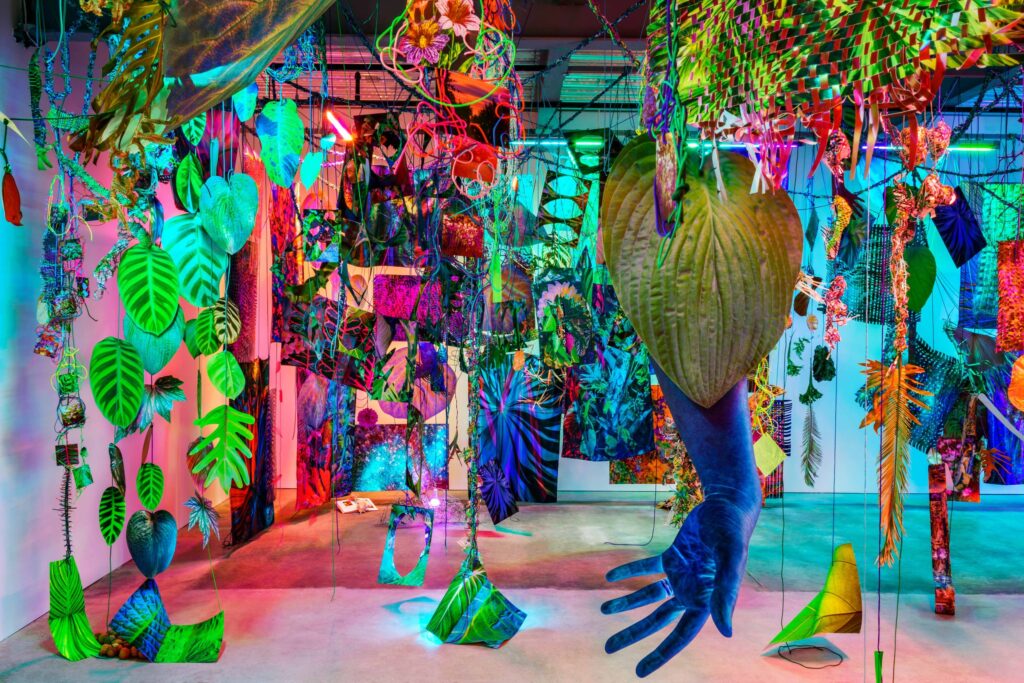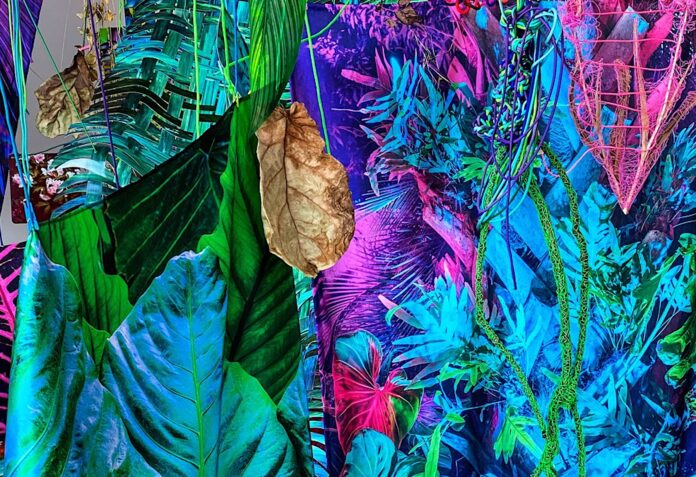In its Minnesota Street Project Gallery Space, SF Camerwork presents Chicago-based Aimée Beaubien’s Matter in the Hothouse (through Sat/9), the recipient of the 2020 Exhibition Award, delayed for two years because of the pandemic. Beaubien’s ambitious and phantasmagoric mixed-media installation is yet another example of the ways in which SF Camerawork has championed experimental photographic work that extends the discipline beyond formal framed prints. Beaubien’s delightfully messy and exuberant installation uses the artificiality and surreal atmosphere of the greenhouse to explore the intersection of nature and culture.
At the heart of Beaubien’s installation, the artist presents many photographs of lush green leaves, printed on paper and satin. As plants are cut for harvest, trimmed for maintenance, or shaped as topiary, Beaubien cuts her photographs. In removing the backgrounds, creating voids of negative space, or slicing the images into strips that she weaves and knots, the artist transforms her photographs beyond the flat rectangle and into dimensional and shaped objects. In the images that are woven together, like textiles or palm frond mats, Beaubien creates moire patterns that optically bulge and stretch, suggesting the process of hybridization, disintegration, or emergence.
As Beaubien has transformed her photographs into sculptural objects, she extends these spatial dynamics to densely fill the entire gallery to create an immersive environment. From floor to ceiling, hanging clusters of images, flowers, and ropes overtake the gallery. Amidst the precariously hung paper and fabric tendrils, viewers must negotiate our own bodies as we navigate the space, possibly an ecological reminder that we humans should tread carefully.
With the prints, ropes, thermoplastics, and colored lighting gels in highly saturated cyans, magentas, and greens, Beaubien renders the “natural” as otherworldly. The clusters of leaves of many different species, like monstera and alocasia, suggest nature’s rich fauna and a hybridity of tropical plant life; in the artificial context of the greenhouse plants from around the world might be growing side-by-side. In addition, scale adds to this sense of wonder with oversized prints of leaves and bulbous accumulations. Beaubien’s strange world highlights how nature is a construct and within the context of a greenhouse, “the natural” is severely altered.

Among the flurry of engaging visual moments within the work, the most interesting are branches and silk flowers cocooned in linear patterns of thermoplastics. Like crude, but intricate line drawings, the brightly colored oozy plastic suggests gigantic spider webs, the decayed remains of leave veins, or flourishes of Victorian ornament.
While Beaubien creates magical moments of visual and material association, the artist may get a little too literal with the inclusion of several botanical books. Placed near lilies and other flowers, the books are opened to reveal pages that offer botanical descriptions. While the information is relevant to the flowers, the relationship between the text and objects could be more unsettling amid the surreal environment. Perhaps had the books been deconstructed or excessive ornamentalized, like the rest of the objects in the installation, they may have contributed to additional formal, narrative, or material poignancy.
Despite my uncertainty about the botanical books, Beaubien’s intriguing installation captures the magic of exploration and the strangeness of the natural world. At every moment in the installation Beaubien creates intriguing formal and material relationships between “the natural” world and the biosphere of the hothouse.
MATTER IN THE HOTHOUSE shows at SF Camerawork through Sat/9. More info here.




